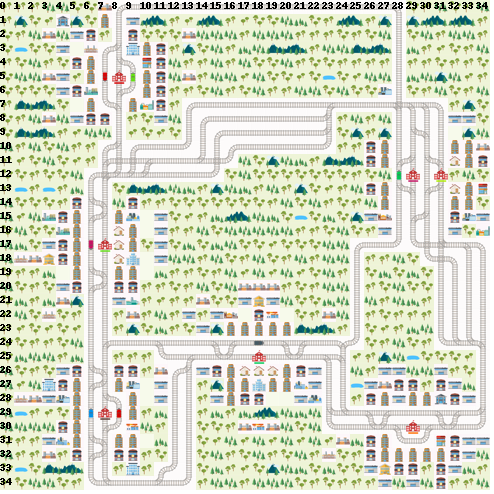Level Generation#
Rail Generators, Line Generators and Timetable Generators#
The separation between rail generation and schedule generation reflects the organisational separation in the railway domain
Infrastructure Manager (IM): is responsible for the layout and maintenance of tracks simulated by
rail_generator.Railway Undertaking (RU): operates trains on the infrastructure Usually, there is a third organisation, which ensures discrimination-free access to the infrastructure for concurrent requests for the infrastructure in a schedule planning phase simulated by
line_generatorandtimetable_generator. However, in the Flatland challenge, we focus on the re-scheduling problem during live operations. So,
Technically rail_generator, line_generator and the timetable_generator are implemented as follows
RailGeneratorProduct = Tuple[GridTransitionMap, Optional[Any]]
RailGenerator = Callable[[int, int, int, int], RailGeneratorProduct]
AgentPosition = Tuple[int, int]
Line = collections.namedtuple('Line', [('agent_positions', IntVector2DArray),
('agent_directions', List[Grid4TransitionsEnum]),
('agent_targets', IntVector2DArray),
('agent_speeds', List[float]),
('agent_malfunction_rates', List[int])])
LineGenerator = Callable[[GridTransitionMap, int, Optional[Any], Optional[int]], Line]
Timetable = collections.namedtuple('Timetable', [('earliest_departures', List[int]),
('latest_arrivals', List[int]),
('max_episode_steps', int)])
timetable_generator = Callable[[List[EnvAgent], DistanceMap, dict, RandomState], Timetable]
We can then produce RailGenerators by completing the following:
def sparse_rail_generator(max_num_cities=5, grid_mode=False, max_rails_between_cities=4,
max_rail_pairs_in_city=4, seed=0):
def generator(width, height, num_agents, num_resets=0):
# generate the grid and (optionally) some hints for the line_generator
...
return grid_map, {'agents_hints': {
'num_agents': num_agents,
'city_positions': city_positions,
'train_stations': train_stations,
'city_orientations': city_orientations
}}
return generator
similarly, LineGenerators:
def sparse_line_generator(speed_ratio_map: Mapping[float, float] = None) -> LineGenerator:
def generator(rail: GridTransitionMap, num_agents: int, hints: Any = None):
# place agents:
# - initial position
# - initial direction
# - targets
# - speed data
# - malfunction data
...
return agents_position, agents_direction, agents_target, speeds, agents_malfunction
return generator
And finally, timetable_generator is called within the RailEnv’s reset() during line generation to create a time table for the trains.
def timetable_generator(agents: List[EnvAgent], distance_map: DistanceMap,
agents_hints: dict, np_random: RandomState = None) -> Timetable:
# specify:
# - earliest departures
# - latest arrivals
# - max episode steps
...
return Timetable(earliest_departures, latest_arrivals, max_episode_steps)
Notice that the rail_generator may pass agents_hints to the line_generator and timetable_generator which the latter may interpret.
For instance, the way the sparse_rail_generator generates the grid, it already determines the agent’s goal and target.
Hence, rail_generator, line_generator and timetable_generator have to match if line_generator presupposes some specific agents_hints.
Currently, the only one used are the sparse_rail_generator, sparse_line_generator and the timetable_generator which works in conjunction with these.
Available Rail Generators#
Flatland provides the sparse_rail_generator, which generates realistic-looking railway networks.
Sparse rail generator#
The idea behind the sparse rail generator is to mimic classic railway structures where dense nodes (cities) are sparsely connected to each other and where you have to manage traffic flow between the nodes efficiently. The cities in this level generator are much simplified in comparison to real city networks but they mimic parts of the problems faced in daily operations of any railway company.

There are a number of parameters you can tune to build your own map and test different complexity levels of the levels.
Note
Some combinations of parameters do not go well together and will lead to infeasible level generation. In the worst case, the level generator will issue a warning when it cannot build the environment according to the parameters provided.
To build an environment, instantiate a RailEnv as follow:
rail_generator=sparse_rail_generator(
max_num_cities=2,
grid_mode=False,
max_rails_between_cities=2,
max_rail_pairs_in_city=2,
seed=0
)
env = RailEnv(
width=30, height=30,
rail_generator=rail_generator,
line_generator=sparse_line_generator(),
number_of_agents=10
)
env.reset()
You can see that you now need both a rail_generator and a line_generator to generate a level. These need to work nicely together. The rail_generator will generate the railway infrastructure and provide hints to the line_generator about where to place agents. The line_generator will then generate a Line by placing agents at different train stations and providing them with individual targets.
You can tune the following parameters in the sparse_rail_generator:
max_num_cities: Maximum number of cities to build. The generator tries to achieve this numbers given all the other parameters. Cities are the only nodes that can host start and end points for agent tasks (train stations).grid_mode: How to distribute the cities in the path, either equally in a grid or randomly.max_rails_between_cities: Maximum number of rails connecting cities. This is only the number of connection points at city border. The number of tracks drawn in-between cities can still vary.max_rails_in_city: Maximum number of parallel tracks inside the city. This represents the number of tracks in the train stations.seed: The random seed used to initialize the random generator. Can be used to generate reproducible networks.